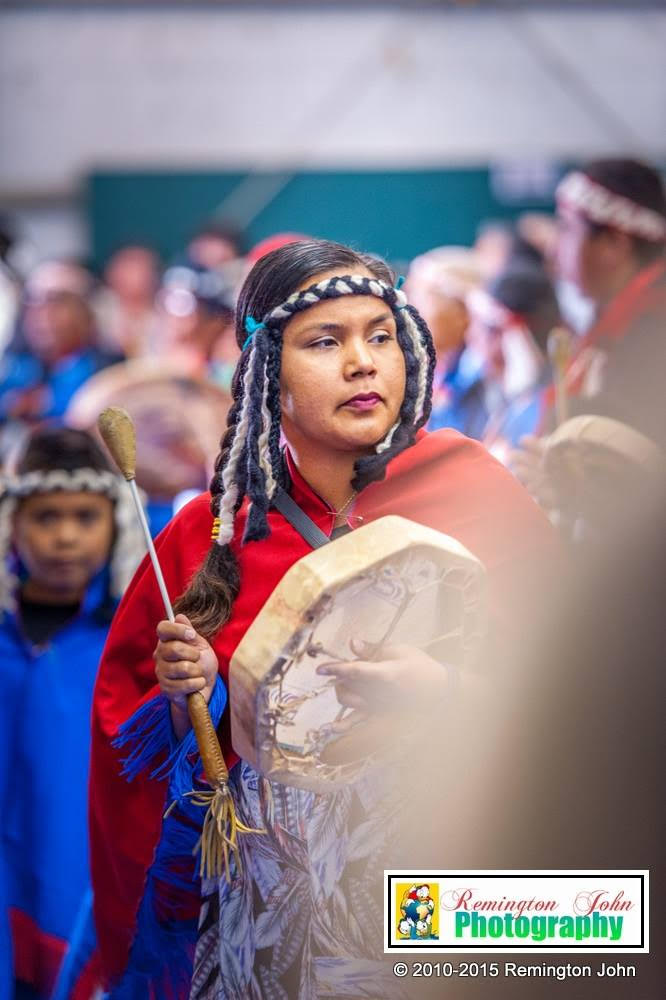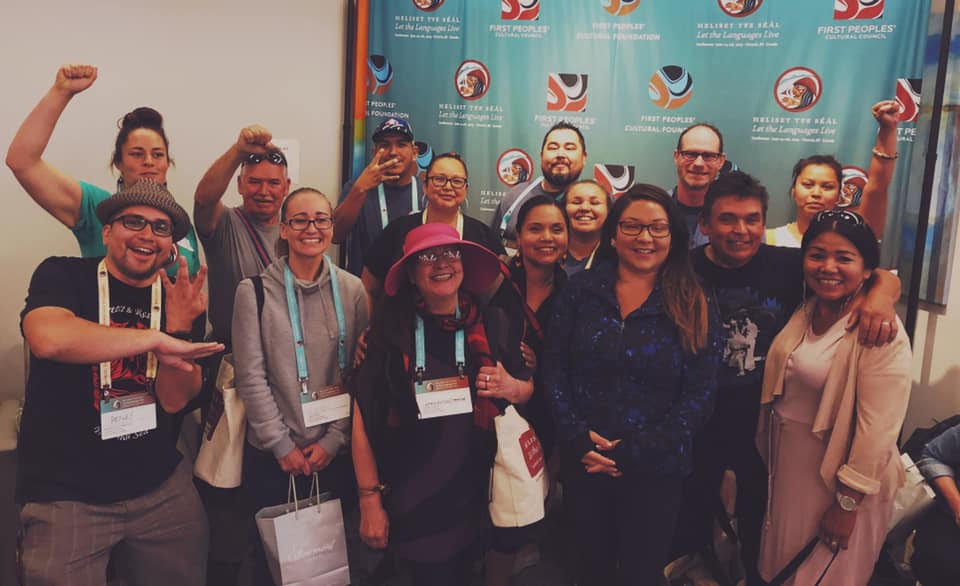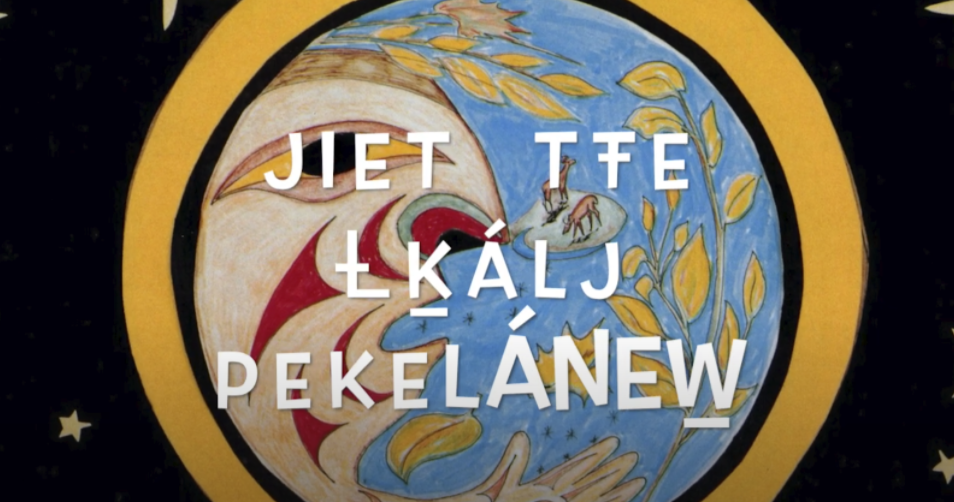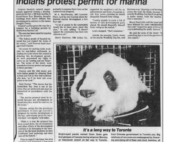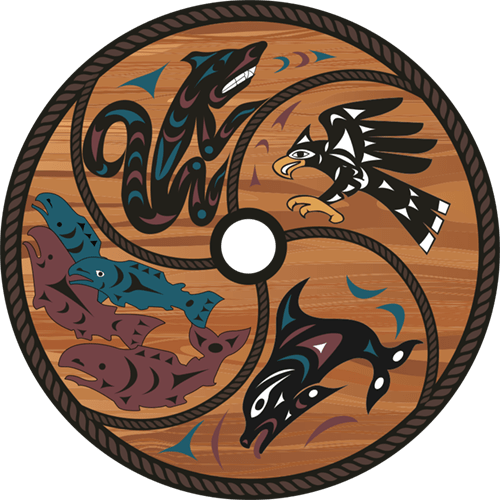SX̱EDŦELISIYE is a W̱SÁNEĆ community member and language revitalizer who has recently translated over 150 books into SENĆOŦEN.
SX̱EDŦELISIYE (Renée Sampson), which means hummingbird woman, is is a proud mother of three daughters (TOLISIYE, LIQIŦIÁ and ŦE,ILIYE). Her passions are language learning, teaching and working with the youth. This photo is Courtesy of and the Copyright of Remington John
SX̱EDŦELISIYE has been working at the W̱SÁNEĆ School Board since 2009. Until last year, she was a kindergarten teacher at the LE,NONET SCUL,AUTW SENĆOŦEN Survival School. Currently, SX̱EDŦELISIYE is the SENĆOŦEN program facilitator for both the ȽÁU,WEL,ṈEW̱ Tribal School and the W̱SÁNEĆ Leadership School. In this position, she is able to continue her years of work to realize the dream she shares with the SELW̱ÁN (elders).
SX̱EDŦELISIYE explains:
“It is the SḰÁLS Ć,SE LÁ,E TŦE SELW̱ÁN (dream of our elders) to have our language taught and have it taught by W̱SÁNEĆ teachers, so the students have our worldview.”
Her recent accomplishment, translating over 150 books into SENĆOŦEN, is just part of a larger vision to create a SENĆOŦEN curriculum beginning in preschool and continuing all the way up to the Ph.D. level.
“My grandparents went to residential school, so I had a yearning for the language. I went and sat with the SELW̱ÁN (elders) and learned from them. That shaped my career. I mentor/apprenticed under J,SIṈTEN (John Elliott) and he and many elders shared their HUĆISTEṈS (teachings-language) which gave me the confidence to pursue teaching in the SENĆOŦEN medium. This is how we began our immersion school.”
The immersion school started with the language nest (LE,NOṈET,SCULÁUTW̱), a program that immerses children as young as three in SENĆOŦEN. Because the first language spoken at home is often English, this program provided an opportunity for parents to learn SENĆOŦEN as well. Alongside their children, parents and adults can enrol in the adult learning program called W̱,SENĆOŦEN,ISTW̱, which is a 2-year language certification program where participants learn from elders in a mentor/apprentice role.
“When the first cohort of the language nest graduated and the children were ready for kindergarten, we thought, well now what? Community feedback has been great, so we built the next levels of the curriculum and now can keep children immersed in SENĆOŦEN until grade 4 when we introduce English as a subject,” SX̱EDŦELISIYE shares.
“We previously had a village there, which is also significant for the history of our people. The site was one of the most productive crabbing areas, a place for deer hunting as well as a place our people used to go out to gather medicines.”
In addition to renaming efforts, the WLC’s environmental committee is working with Parks Canada to remove the invasive plants that are growing in the parks all around the Gulf Islands.
Shown above, STÁSEN TŦE SENĆOŦEN, language warriors.
While SX̱EDŦELISIYE and her mentor/apprentice colleagues were working to design the programs and curriculum that would eventually teach SENĆOŦEN as far as Grade seven, the need for SENĆOŦEN readers and resources became evident.
SX̱EDŦELISIYE explains, “We selected the most high-frequency words, what we call sight words from the SENĆOŦEN dictionary. We chose 120 words and made books for each of them. Now we’re working on designing a levelled reading program. This summer, taking knowledge from the elders, we created another 150 books, which took us just over a year.”
Teaching remotely and online due to COVID necessitated further resource creation. Accordingly, SX̱EDŦELISIYE and her peers created audiobooks, a YouTube channeland a partnership with simbi.com to ensure the newly created SENĆOŦEN books are widely accessible. There are now 200+ youtube videos on the SENĆOŦEN YouTube channel. Stay tuned for SȾÁSEN TŦE SENĆOŦEN language department launch of sencoten.org this spring, which will have audio, visual and lessons on-line and many SENĆOŦEN resources in one place. “When the first cohort of the language nest graduated and the children were ready for kindergarten, we thought, well now what? Community feedback has been great, so we built the next levels of the curriculum and now can keep children immersed in SENĆOŦEN until grade 4 when we introduce English as a subject,” SX̱EDŦELISIYE shares.
“We previously had a village there, which is also significant for the history of our people. The site was one of the most productive crabbing areas, a place for deer hunting as well as a place our people used to go out to gather medicines.”
In addition to renaming efforts, the WLC’s environmental committee is working with Parks Canada to remove the invasive plants that are growing in the parks all around the Gulf Islands.
Shown above: one of the newest videos added to theSENĆOŦEN YouTube Channel
The impact of providing comprehensive education in SENĆOŦEN goes far beyond linguistics. SX̱EDŦELISIYE explains, “With language immersion, the students are also immersed in the W̱SÁNEĆ worldview because the culture and language are inseparable. The children are then grounded in their ways of being, in their culture. They have a solid identity. EWES ṮEQ TŦE SONUSE – in this way we don’t let the fire go out.”
While much has been done, there is much still to do. Accordingly, a lot of resources are being allocated to support additional SENĆOŦEN programming. The W̱SÁNEĆ schools are currently expanding with a new wing in the works (preschool to grade six) and 4 more classes being added to the the W̱SÁNEĆ Leadership School. The dream is to extend the SENĆOŦEN curriculum into Grade 12 and beyond so the youth can be completely bilingual. To achieve this, SX̱EDŦELISIYE is working on a ladder from Grade 7-12, modelled after a charter school in Hawaii.
The hope is that immersion students will graduate high school and transition into the W̱,SENĆOŦEN,ISTW̱ program. This two-year language certificate program ladders into a SENĆOŦEN B.Ed, a program that has been running for 5 years. From there, the B.Ed can be applied to a Masters degree in language revitalization and finally a Ph.D. in education. SX̱EDŦELISIYE mentioned that she hopes to see the immersion cohorts continue their language journey and get their Ph.D’s with their strong foundation in SENĆOŦEN.
“It’s been 50 years or more since children have been speaking our language, it is our ĆELÁṈEN our birthright, it is in our DNA, and it it beautiful to hear our children speak, pray and sing in SENĆOŦEN once again. I’d really like to thank our W̱SÁNEĆ communities and family for participating in language revitalization and believing in the benefits of having your children immersed in SENĆOŦEN.
While a career in education is an obvious career path. SX̱EDŦELISIYE believes strongly there are many additional benefits to fluency SENĆOŦEN:
“Right now the language focus in post-secondary is in linguistics and education but it can and should expand into all areas of governance, law, health and wellness. We want to ensure EWES ṮEQ TŦE SONUSE / we don’t let the fire (language) go out in our people, we want our children/youth to walk proudly as W̱SÁNEĆ adults with a strong W̱SÁNEĆ identity.
SḰÁLS Ć,SE LÁ,E TŦE SELW̱ÁN, in the words from our Elders, it’s important to be gentle with those just starting to learn the language, ĆOȻES ȻENS TOLNEW̱, use what you know, start where you are with what you have.”
To stay up to date on this story, please sign up for our newsletter.
RECENT POSTS
How are we doing?
“My grandparents went to residential school, so I had a yearning for the language. I went and sat with the SELW̱ÁN (elders) and learned from them. That shaped my career. I mentor/apprenticed under J,SIṈTEN (John Elliott) and he and many elders shared their HUĆISTEṈS (teachings-language) which gave me the confidence to pursue teaching in the SENĆOŦEN medium. This is how we began our immersion school.”


